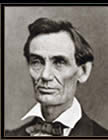An Analytical Biography of a Great Mind- by Edward J. Kempf
- PART I
- PREFACE
- INTRODUCTION
- Chapter I - Lincoln's Physical Costitution
- Hereditary Determination
- Hypersensitive Hypokinetic Constitution
- Meaning of Facial Asymmetries
- Fracture of Skull and Injury of Brain in Boyhood
- Diagnosis of Cerebral Lesion
- Diplopia and Eyestrain
- Borglum's Interpretation of Lincoln's Face
- Enigmatical Character of Facial Expression
- Preference for Photographs of Right Side of Face
- References
Enigmatical Character of facial expression
The right side of Lincoln's face was animated and normally emotionally expressive, whereas the left side functioned more weakly, looked duller and strangely out of harmony. The meaning of the duality and uncoordinated changes in his facial expression baffled everyone.* Strangers who estimated the man by his dull, perplexed face and sad, tired eyes were always astonished by the quick change of his expression to alertness when he became interested in their conversation and wanted to make some contribution to it. Many officials, including lawyers, generals and members of his cabinet, upon first acquaintance, thought themselves superior to this ugly, dull, sad, weak man, only to find themselves amazed and mastered by his ready wit, common sense, logical intelligence and strength of character upon being required to look out for himself.
Herndon was no doubt the most frequent, intimate and interested daily observer of Lincoln's personality and physical constitution, as his law partner, through the years of 1843 to 1861. He has stated (1889) that Lincoln's most marked and persistent characteristic was a predisposition to become melancholy or sad and abstracted. This attitude showed in his facial expression when sitting alone or in a group and not taking an active interest in the conversation. Many other intimate friends of Lincoln were similarly impressed, as recorded in various biographies. Some of his friends thought, because of the muddy, leathery condition of his skin, this facial lapse was due to chronic indigestion and "insufficient secretion of bile." The morbidity was caused, Herndon said, by some "occult condition" that could not be explained by observation or reasoning. It was "ingrained, necessarily hereditary a part of his nature." "Lincoln was a sad looking man whose melancholy dripped from him as he walked." "The look of sadness was more or less accentuated by a peculiarity of one eye [left], the pupil of which had a tendency to turn or roll slightly toward the upper lid, whereas the other one maintained its normal position equidistant between the upper and lower lids." He also noticed that the tip of his nose and mouth turned toward the right. "Mr. Lincoln was a peculiar, mysterious man . . . had a double consciousness, a double life." He "quickly passed from one state of consciousness to another and different state."(Letter to J. Weik, February 21, 1891; Hertz, 1938.)
Actually, as Lincoln's life mask and photographs show, the right half of the lower lip always protruded more than the left half and was pulled with the other muscles of the mouth slightly to the right side. When reading intently or thinking actively the degree of dominance in neuromuscular activity of the right side of his face tended generally to increase over that of the relatively hypotonic left, which gave his expression a perplexed quality that was misunderstood as a sign of mental confusion by those who would read his face. (See additional information by Herndon in Chapter XIX.)

